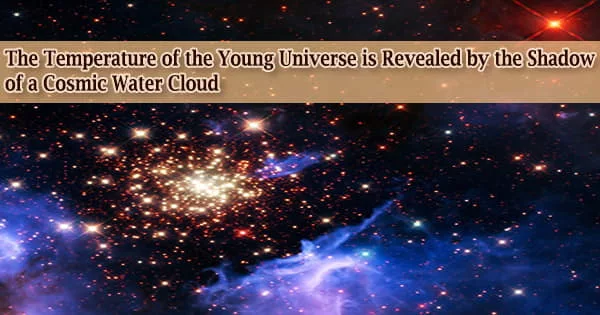Only 880 million years after the Big Bang, an international team of astrophysicists has developed a new method for estimating the cosmic microwave background temperature of the newborn Universe.
The temperature of the cosmic microwave background radiation, a relic of the energy generated by the Big Bang, has been measured for the first time at such a young epoch of the Universe.
The current cosmological model assumes that the Universe has cooled and continues to cool since the Big Bang. The concept also explains how the cooling process should work, but it has only been directly proven during recent cosmic periods.
The revelation not only marks a significant step forward in the evolution of the cosmic background temperature, but it also has ramifications for the elusive dark energy. Nature published an article today titled “Microwave background temperature at a redshift of 6.34 from H2O absorption.”
The astronomers observed HFLS3, a large starburst galaxy at a distance of only 880 million years after the Big Bang, using the NOEMA (Northern Extended Millimeter Array) observatory in the French Alps, the Northern Hemisphere’s most powerful radio telescope.
A screen of cold water gas was discovered that casts a shadow on the cosmic microwave background radiation. The shadow appears because the cooler water absorbs the hot microwave radiation on its way to Earth, revealing the temperature difference through its blackness.
Quite early, about 1.5 billion years after the Big Bang, the cosmic microwave background was already too cold for this effect to be observable. We have therefore a unique observing window that opens up to a very young Universe only.
Dr. Dominik Riechers
The difference shows the temperature of the Big Bang’s relic radiation, which was around seven times higher than it is today, as indicated by other measured features of the starburst.
“Besides proof of cooling, this discovery also shows us that the Universe in its infancy had some quite specific physical characteristics that no longer exist today,” said lead author Professor Dr. Dominik Riechers from the University of Cologne’s Institute of Astrophysics.
“Quite early, about 1.5 billion years after the Big Bang, the cosmic microwave background was already too cold for this effect to be observable. We have therefore a unique observing window that opens up to a very young Universe only,” he continued.
In other words, if a galaxy with otherwise comparable features as HFLS3 existed today, the water shadow would not be visible due to the lack of the essential temperature contrast.
“This important milestone not only confirms the expected cooling trend for a much earlier epoch than has previously been possible to measure but could also have direct implications for the nature of the elusive dark energy,” said co-author Dr. Axel Weiss from the Max Planck Institute for Radio Astronomy (MPIfR) in Bonn.
Dark energy is considered to be responsible for the Universe’s accelerated expansion during the last few billion years, but its properties are unknown because it can’t be examined directly with present facilities and tools.
However, its features have an impact on the evolution of cosmic expansion and, as a result, the rate at which the Universe cools throughout cosmic time. For the time being, the properties of dark energy are consistent with those of Einstein’s cosmological constant, based on this experiment.
“That is to say, an expanding Universe in which the density of dark energy does not change,” explained Weiss.
The team is now looking for more of these cold-water clouds across the sky after discovering one in a starburst galaxy in the early Universe. Their goal is to trace the cooling of the Big Bang echo across the first 1.5 billion years of the universe’s history.
“This new technique provides important new insights into the evolution of the Universe, which are very difficult to constrain otherwise at such early epochs,” Riechers said.
“Our team is already following this up with NOEMA by studying the surroundings of other galaxies,” said co-author and NOEMA project scientist Dr. Roberto Neri.
“With the expected improvements in precision from studies of larger samples of water clouds, it remains to be seen if our current, basic understanding of the expansion of the Universe holds.”
Dominik Riechers (University of Cologne) conducted the study together with his colleagues Axel Weiss (Max Planck Institute for Radio Astronomy, MPIfR), Fabian Walter (Max Planck Institute for Astronomy, MPIA), Christopher L. Carilli (National Radio Astronomy Observatory, NRAO), Pierre Cox (Institut d’Astrophysique de Paris, IAP, and Sorbonne Université), Roberto Decarli (INAF Osservatorio di Astrofisica e Scienza dello Spazio), and Roberto Neri (Institut de RadioAstronomie Millimétrique, IRAM).
The National Science Foundation of the United States, the Alexander von Humboldt Foundation, the Max Planck Society, the Institut National des Sciences de l’Univers/Centre National de la Recherche Scientifique, and the Instituto Geográfico Nacional all contributed to the research.





